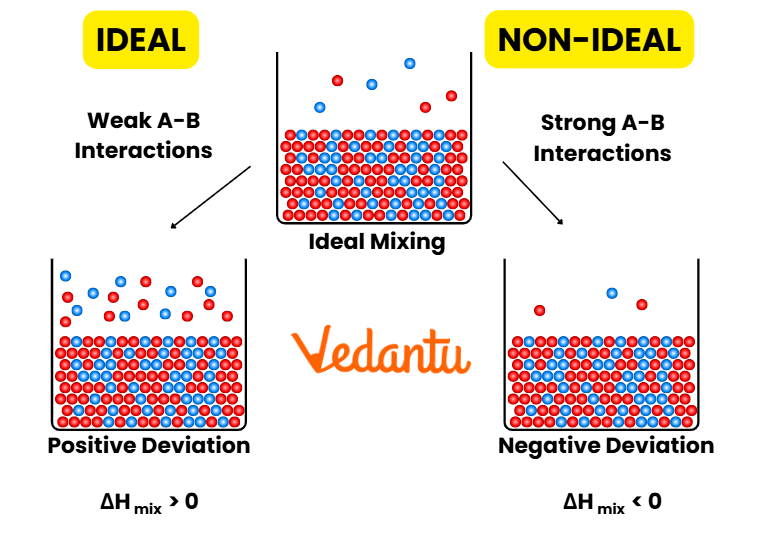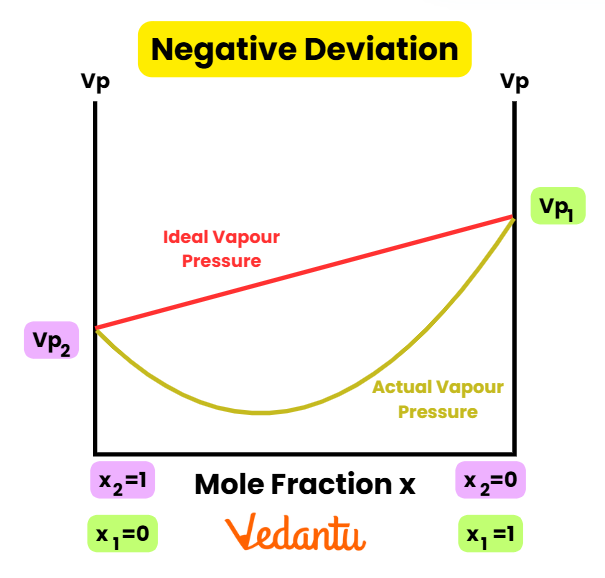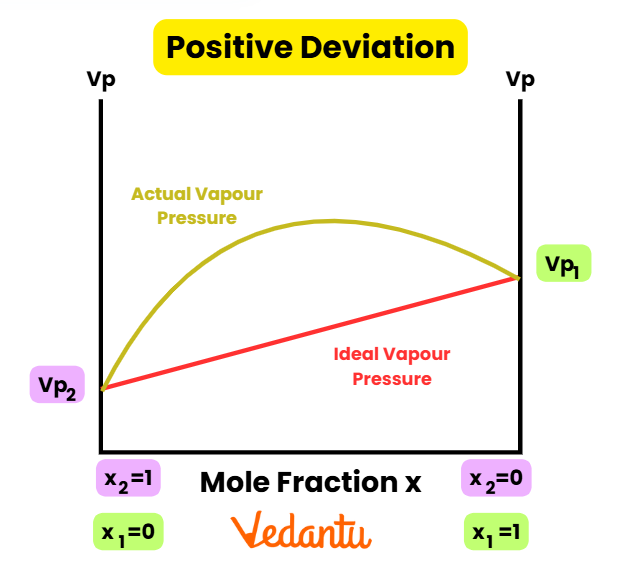




Learn about Raoult's Law Definition, Formulas, and Types of Deviation with Examples
Raoult’s Law is a crucial concept in Chemistry that describes the relationship between the vapour pressure of a solvent and its concentration in an ideal solution. The law states that the partial vapour pressure of a solvent is proportional to its mole fraction in a mixture. This principle helps explain several physical phenomena like the lowering of vapour pressure when a solute is added to a solvent.
This page aims to provide a detailed yet easy-to-understand explanation of Raoult’s Law, covering its mathematical formulation, key concepts, real-world applications, and common deviations from ideal behaviour.

What is Raoult's Law?
Raoult’s Law, formulated by François-Marie Raoult in 1887, explains the relationship between the vapour pressure of a solvent in a solution and its mole fraction. This fundamental principle in physical chemistry helps predict the vapour pressure in ideal mixtures and serves as the basis for understanding colligative properties like boiling point elevation, freezing point depression, and osmotic pressure.
Key Concepts
Solution: A homogeneous mixture of solute and solvent.
Solute: The substance dissolved in the solvent.
Solvent: The substance doing the dissolving.
Mole Fraction (X): Ratio of the moles of a component to the total moles in the solution.
Vapour Pressure: Pressure exerted by the vapour of a liquid in equilibrium with its liquid form.
Raoult’s Law Explained
Raoult’s Law states that the partial vapour pressure of a solvent in a solution is equal to the vapour pressure of the pure solvent multiplied by its mole fraction in the solution:
Where:
In simpler terms, when you add a solute (like salt) to a solvent (like water), the vapour pressure decreases due to fewer solvent molecules being available to escape into the vapour phase.
Ideal vs. Non-Ideal Solutions
Raoult’s Law applies to ideal solutions, where the intermolecular forces between different components are similar to those between like molecules. In non-ideal solutions, deviations from Raoult’s Law occur due to differences in intermolecular attractions, which result in either higher or lower vapour pressures than predicted.

Example of Raoult’s Law
Consider a solution of 60% water (
The total vapour pressure is the sum of these partial pressures:
17.42 kPa, lower than the vapour pressure of pure water.
Deviations from Raoult’s Law
Raoult’s Law holds for ideal solutions but often deviates in real solutions due to varying intermolecular forces. There are two main types of deviations:
Negative Deviation: Occurs when the vapour pressure is lower than expected. This happens when the intermolecular forces between the components are stronger than those in the pure substances.
Example: Chloroform and acetone form a solution with negative deviation due to hydrogen bonding.

Positive Deviation: Happens when the vapour pressure is higher than expected. This occurs when the intermolecular forces between unlike molecules are weaker than those between similar molecules.
Example: A mixture of benzene and methanol exhibits positive deviation as both components are more likely to escape into the vapour phase than in their pure form.

Applications of Raoult’s Law
Colligative Properties: Used to calculate changes in boiling and freezing points of solutions.
Osmotic Pressure: Essential for understanding processes like reverse osmosis.
Concentration Determination: Vapour pressure lowering can help determine solute concentration in solutions.
Limitations of Raoult’s Law
Raoult's Law is idealiesd and doesn’t apply well to real-world mixtures where intermolecular forces differ significantly.
These deviations become noticeable in non-ideal solutions, such as those with strong hydrogen bonds or highly different molecular sizes.
Conclusion
Raoult’s Law provides a fundamental framework for understanding vapour pressure in ideal solutions. However, real solutions often show deviations due to differences in molecular interactions, making it essential to consider these deviations when applying the law in practical scenarios.
Solved Examples
Example 1: Calculating Total Vapor Pressure
Problem:
A solution is prepared by mixing 50 g of benzene (C₆H₆) and 50 g of toluene (C₇H₈). The vapor pressure of pure benzene and pure toluene at 25°C are 100 mmHg and 30 mmHg, respectively. Calculate the total vapor pressure of the solution assuming ideal behavior.
Solution:
Molar masses:
Benzene:
Toluene:
Number of moles:
Moles of benzene:
Moles of toluene:
Mole fractions:
Mole fraction of benzene:
Mole fraction of toluene:
Partial vapor pressures (using Raoult's Law):
Partial pressure of benzene:
Partial pressure of toluene:
Total vapor pressure:
Answer: The total vapor pressure of the solution is 67.87 mmHg.
Example 2: Change in Freezing Point Using Raoult's Law
Problem:
A solution is prepared by dissolving 1.5 mol of glucose (C₆H₁₂O₆) in 1 kg of water. Assuming the vapor pressure of pure water is 23.76 mmHg at 25°C, calculate the vapor pressure of the solution.
Solution:
Moles of solvent (water):
Moles of water:
Mole fraction of water:
Vapor pressure of the solution:
Answer: The vapor pressure of the solution is 23.13 mmHg.
Example 3: Depression in Vapor Pressure
Problem:
A solution contains 0.5 mol of urea in 500 g of water. The vapor pressure of pure water at 50°C is 92.51 mmHg. Calculate the vapor pressure of the solution.
Solution:
Moles of water:
Mole fraction of water:
Vapor pressure of the solution:
Answer: The vapor pressure of the solution is 90.84 mmHg.
FAQs on Raoult's Law with Examples
1. What is Raoult's Law Class 12?
In Class 12, Raoult's Law explains that the partial vapor pressure of a solvent decreases upon adding a non-volatile solute, and the relative lowering of vapor pressure is equal to the mole fraction of the solute.
2. What is the formula for Raoult's Law?
The formula for Raoult's Law is:
PA=XA⋅PA0P_A = X_A \cdot P_A^0PA=XA⋅PA0
where:
PAP_APA = partial vapor pressure of the component
XAX_AXA = mole fraction of the component
PA0P_A^0PA0 = vapor pressure of the pure component
3. What causes positive deviation from Raoult's Law?
Positive deviation occurs when the intermolecular forces between unlike molecules are weaker than those between like molecules, resulting in higher vapour pressure than expected from Raoult's Law.
6. How does Raoult's Law apply to a non-volatile solute?
For a non-volatile solute, Raoult's Law states that the vapour pressure of the solution is lowered, as the non-volatile solute does not contribute to the vapour pressure. The vapour pressure is determined solely by the volatile solvent.
7. What are the applications of Raoult's Law?
Raoult's Law is used to calculate:
Boiling point elevation
Freezing point depression
Relative lowering of vapour pressure is important in fields like chemistry and chemical engineering.
8. What are the limitations of Raoult's Law?
Raoult's Law is limited to ideal solutions and may not hold for non-ideal solutions where strong interactions or deviations exist between solute and solvent molecules.

















